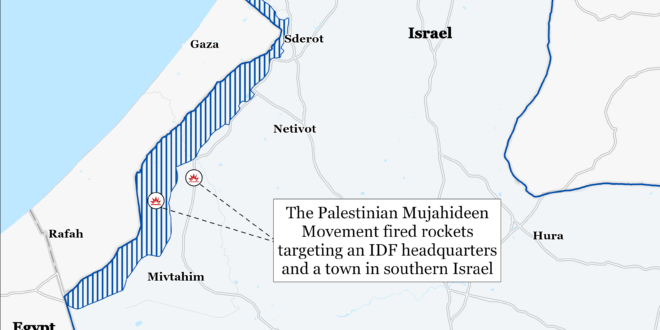Iranian-backed Iraqi militias appear to have resumed their attack campaign targeting US forces in Iraq. Iranian-backed Iraqi militias launched two one-way attack drones targeting US and coalition forces at Ain al Asad Airbase in Anbar Province, Iraq on July 16, according to two Iraqi militia “officials” cited by Western media.[i] An anonymous US-led coalition source told Iraqi media that US air defense systems intercepted both drones.[ii] No group has officially claimed the attack at the time of writing, though an Iraq-focused analyst reported that a propaganda outlet affiliated with Harakat Hezbollah al Nujaba claimed the attack on July 16.[iii] The Iranian-backed Iraqi militias previously threatened on or before June 5 to attack US forces in Iraq if the Iraqi prime minister failed to set a date for US troop withdrawal within 40 days, and the militias’ coordinating body also threatened to resume attacks on June 19.[iv] Ali al Fatlawi, a leader in Ansar Allah al Awfiya cited by Shafaq on July 17, claimed that the drone attack on Ain al Asad Airbase meant attacks against US forces had resumed.[v] Fatlawi did not specify which militia conducted the attack.[vi] Fatlawi is also a member of Asaib Ahl al Haq‘s parliamentary bloc.[vii] This attack marks the second Iranian-backed Iraqi militia attacks on a US base in Iraq since Iraqi militias suspended their attack campaign targeting US forces in February 2024.[viii]
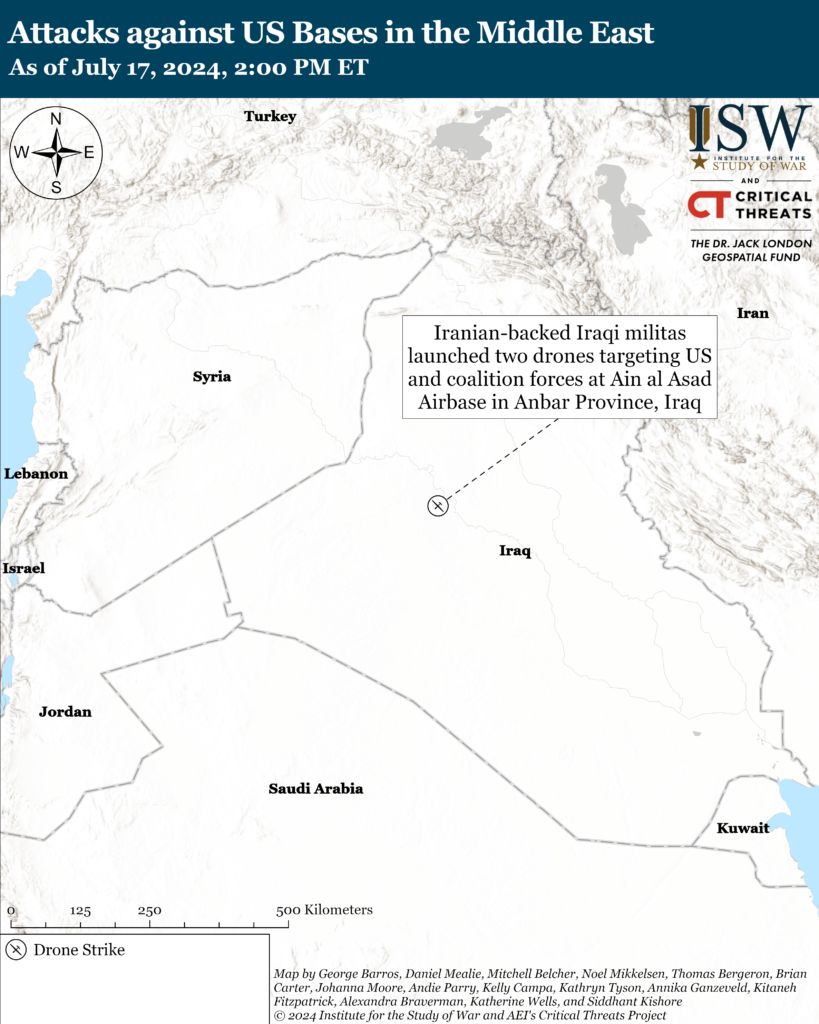
An Iraqi delegation will travel to Washington, DC, on an unspecified date in July 2024 to continue negotiations over the end of the International Coalition’s mission in Iraq.[ix] Anonymous Iraqi political sources cited by Iraqi news outlet al Mada claimed that the Iraqi delegation will request the withdrawal of US and coalition forces from Iraq in three to four months. The same sources believe the United States will request a longer withdrawal timetable over three to five years. It is unclear how the anonymous Iraqi political sources have access to this information about US calculations. The United States and Iraq have been evaluating a timeline to withdraw International Coalition forces from Iraq following the January 2024 Iranian-backed Iraqi militia attack that killed three US servicemembers.[x]
Iran is still attempting to establish a permanent naval base on Sudan’s Red Sea coast following unsuccessful bilateral talks in March 2024. The Wall Street Journal initially reported in March 2024 that Iran unsuccessfully tried to persuade Sudan to allow Iran to build a permanent naval base in Port Sudan on the Red Sea.[xi] France-based, Sudanese outlet the Sudan Tribune reported on July 16 that the Sudanese Armed Forces rejected an Iranian proposal to permanently station an Iranian military vessel in Port Sudan in exchange for continued Iranian military aid to the Sudanese Armed Forces.[xii] The July 16 report stated that Iran modified its initial proposal to instead request to establish a dual-use commercial and military port at Port Sudan. Iran’s initial proposal was to establish a solely military-use port, according to the Wall Street Journal.[xiii] The most recent proposal was also rejected by Sudanese officials, according to the Sudan Tribune report. The July 16 report likely indicates that Iran continued talks with Sudan after its initial talks as reported by the Wall Street Journal in March 2024.
Sudanese Armed Forces officials reportedly rejected these Iranian proposals due to concerns about potential backlash from Saudi Arabia, Egypt and Western countries. Port Sudan is located approximately 200 miles west of Saudi Arabia—separated by the Red Sea. A senior Sudanese intelligence adviser to the Sudanese Armed Forces stated in March 2024 that Sudan rejected the initial proposal to ”avoid alienating the US and Israel.”[xiv] Egypt, Saudi Arabia, and Israel all have direct access to the Red Sea, and an Iranian presence on the Red Sea would enable Iran to support longer-range naval operations to disrupt international shipping to any of these states, should Iran choose to do so.[xv] Sudan’s rejection of these proposals has not visibly affected Iran’s decision to supply drones to the Sudanese Armed Forces. Iran has supplied the Sudanese Armed Forces with drones, such as the Mohajer-6, to use against the paramilitary Rapid Support Forces in the ongoing Sudanese Civil War.[xvi] CTP-ISW previously assessed in March 2024 that Iran would use a naval base in Sudan to support out-of-area naval operations and attacks on international shipping in the Red Sea.
Hamas likely retains the institutional knowledge and skilled commanders required to reconstitute despite the loss of several high-ranking Hamas commanders in the Gaza Strip since October 2023. The IDF has killed three of five Hamas Brigade commanders in the Gaza Strip.[xvii] The original Hamas Gaza City and Rafah Brigade commanders remain active in the Gaza Strip, and the IDF has conducted operations in both Rafah and Gaza City in recent weeks targeting forces under the command of the last two pre-October 7 brigade commanders.[xviii] Many of the senior Hamas military commanders whom Israel has killed in this war have decades of experience fighting Israel, and their loss will make reconstitution more challenging. Hamas made a deliberate choice to structure its military wing to survive Israeli military action by building a resilient military organization modeled on conventional militaries, however. Militaries design their command structures to ensure continuity of command during combat as units take casualties and leaders die. Killed Hamas commanders are almost certainly backfilled by their deputies and subordinates. These deputies and subordinates have survived nine months in a Darwinian combat environment, which can help lower-ranking commanders develop skills and teach them lessons they may not otherwise develop in peacetime when the stakes are much lower. These commanders will likely quickly assume and execute reconstitution tasks, such as reorganization, recruiting personnel, and replenishing stockpiles of military equipment and weapons across the Gaza Strip.[xix]
Hamas is deploying poorly trained new recruits in the Gaza Strip, probably due to its inability to effectively train new fighters amid Israeli military pressure. This inability to effectively train fighters will not persist if military pressure—from Israel or a different security force—does not continue. Hamas is recruiting new fighters to replace the reportedly 14,000 Palestinian fighters killed in the Gaza Strip since the start of the war.[xx] The IDF reported that these new recruits are ”low quality,” however.[xxi] The ”low-quality” of new fighters is unsurprising given that Hamas does not have the freedom of movement or safe spaces to train new recruits in the same way new fighters would have been trained before October 7th. The IDF Air Force continues to strike with ease across the Gaza Strip. Training would increase the signature of Hamas fighters and present them as targets for the IDF Air Force. These fighters would be able improve their capabilities without a non-Hamas security presence to continue to disrupt training activities, however. An IDF withdrawal from the Gaza Strip without a viable alternative security force to challenge Hamas’ monopoly on violence would provide Palestinian militias the space to rebuild fighter capacity. Raids can temporarily disrupt but will not stop a reconstitution process.[xxii]
Key Takeaways:
- Iraq: Iranian-backed Iraqi militias appear to have resumed their attack campaign targeting US forces in Iraq.
- Gaza Strip: Hamas likely retains the institutional knowledge and skilled commanders required to reconstitute despite the loss of several high-ranking Hamas commanders in the Gaza Strip since October 2023. The IDF has killed three of five Hamas Brigade commanders in the Gaza Strip.
- Hamas Reconstitution: Hamas is deploying poorly trained new recruits in the Gaza Strip, probably due to its inability to effectively train new fighters amid Israeli military pressure. This inability to effectively train fighters will not persist if military pressure—from Israel or a different security force—does not continue.
- Iran in Africa: Iran is still attempting to establish a permanent naval base on Sudan’s Red Sea coast following unsuccessful bilateral talks in March 2024. Sudanese Armed Forces officials reportedly rejected these Iranian proposals due to concerns about potential backlash from Saudi Arabia, Egypt and Western countries.
- Lebanon: Nasrallah gave a televised speech on July 17 commemorating the Shia holy Day of Ashura and stated that Hezbollah would hit new Israeli targets if Israel “continues to target civilians” in Lebanon. CTP-ISW has observed that Hezbollah has attacked areas further south in Israel in retaliation for recent Israeli strikes targeting Hezbollah leaders.
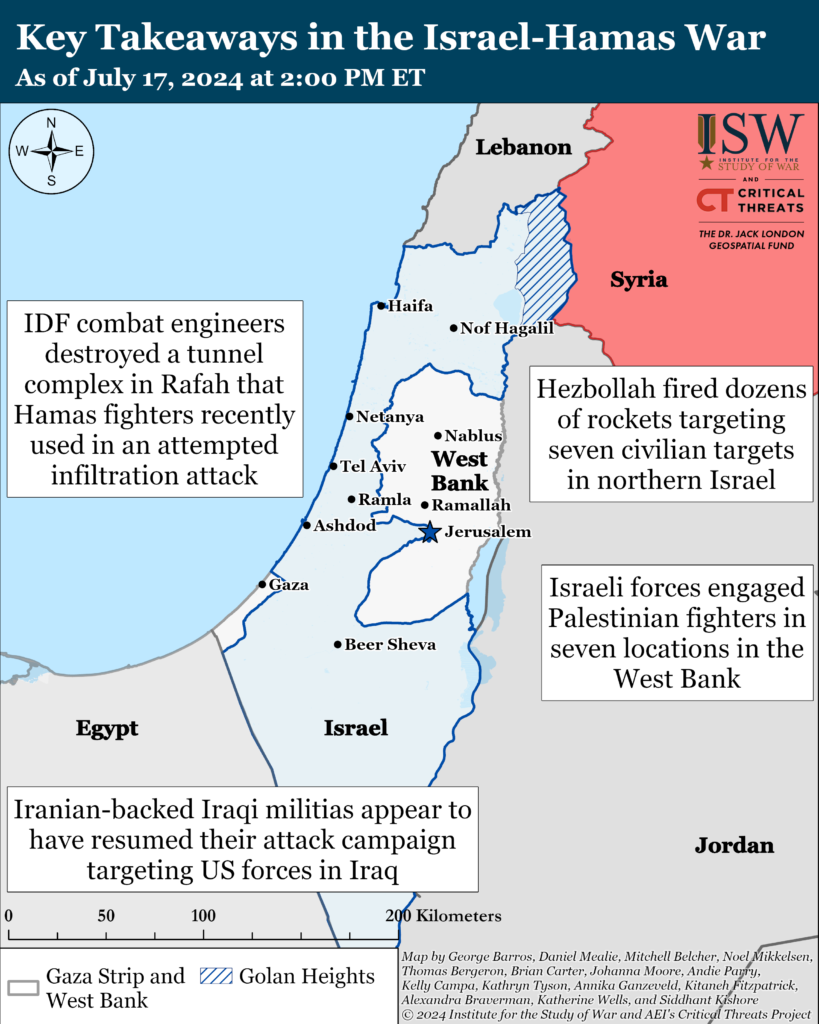
Gaza Strip
Axis of Resistance objectives:
Erode the will of the Israeli political establishment and public to sustain clearing operations in the Gaza Strip
Reestablish Hamas as the governing authority in the Gaza Strip
The Israel Defense Forces (IDF) struck several targets in the northern Gaza Strip on July 17. Israeli aircraft struck a Hamas sniper and fighter in an unspecified area of the northern Gaza Strip.[xxiii] The IDF Air Force also targeted the site and launcher that Palestinian Islamic Jihad (PIJ) used to target Sderot on July 16.[xxiv]
The IDF 3rd and 8th Brigades continued clearing operations along the Netzarim Corridor on July 17.[xxv] Israeli forces engaged Palestinian fighters and demolished buildings that Palestinian fighters used to observe the IDF along the corridor.[xxvi] Palestinian journalists reported Israeli armor operated along the southern side of the Netzarim Corridor near Nuseirat and Bureij.[xxvii] Palestinian militias did not claim attacks targeting Israeli forces along the corridor on July 17.
The IDF 162nd Division continued clearing operation in Rafah on July 17. The IDF Nahal Brigade engaged a Palestinian militia cell and destroyed a rocket launcher used to target Israeli forces in Rafah.[xxviii] IDF combat engineers are reportedly expanding the width of the Philadelphi Corridor to 800 meters by demolishing structures along the Gaza Strip-Egypt border.[xxix] Hamas targeted Israeli armor with a rocket-propelled grenade in eastern Rafah[xxx] The al Aqsa Martyrs’ Brigades mortared Israeli forces holding the Rafah border crossing and fired a sniper rifle at an Israeli infantryman in Yabna refugee camp in central Rafah[xxxi][xxxii]
IDF combat engineers destroyed a tunnel complex in Rafah that Hamas fighters recently used in an attempted infiltration attack. Reconnaissance and combat engineer units led by the IDF 143rd (Gaza) Division demolished a three-kilometer tunnel network used by four Hamas fighters to emerge 200-meters from the Israel-Gaza Strip border in Rafah on June 6.[xxxiii] Four Hamas fighters armed with small arms and rocket-propelled grenades (RPG) emerged from the tunnel under the cover of a thick fog during the incident.[xxxiv] The IDF killed three of the four Palestinian fighters 400 meters from the Israeli border in the Gaza Strip.[xxxv] One Israeli soldier died during the incident.[xxxvi] Palestinian fighters have very rarely attempted to infiltrate Israeli territory since the October 7, 2023, attack. The tunnel network contained blast doors, electricity, and a living space for Hamas fighters. [xxxvii]
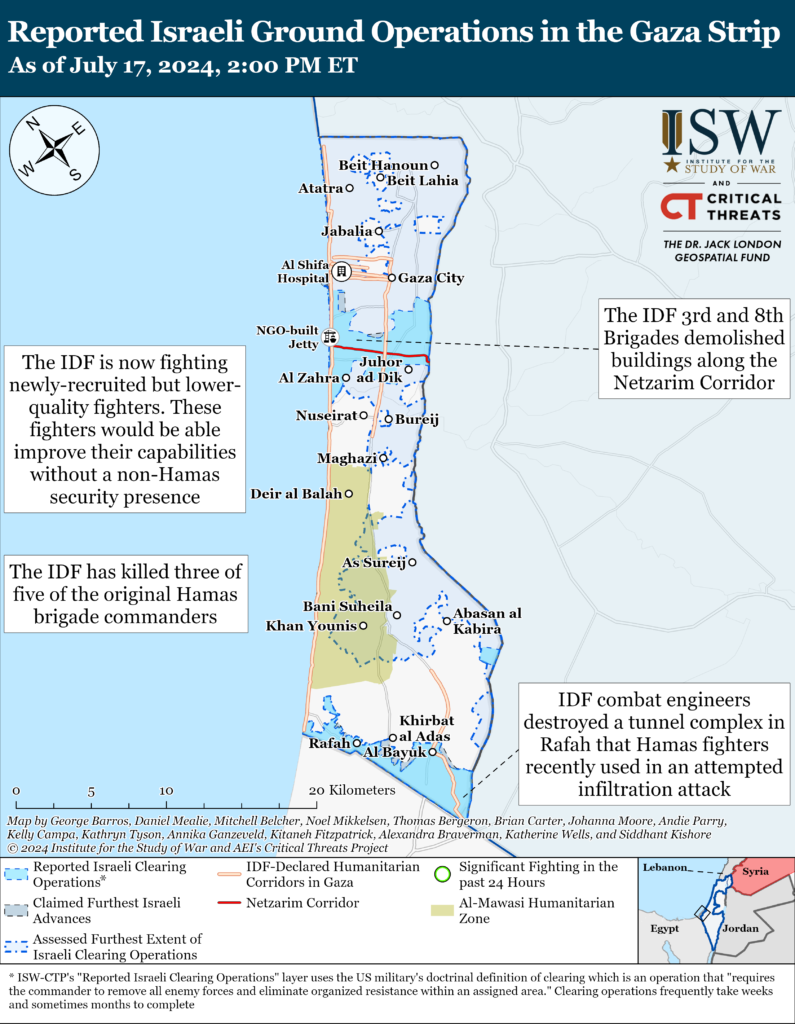
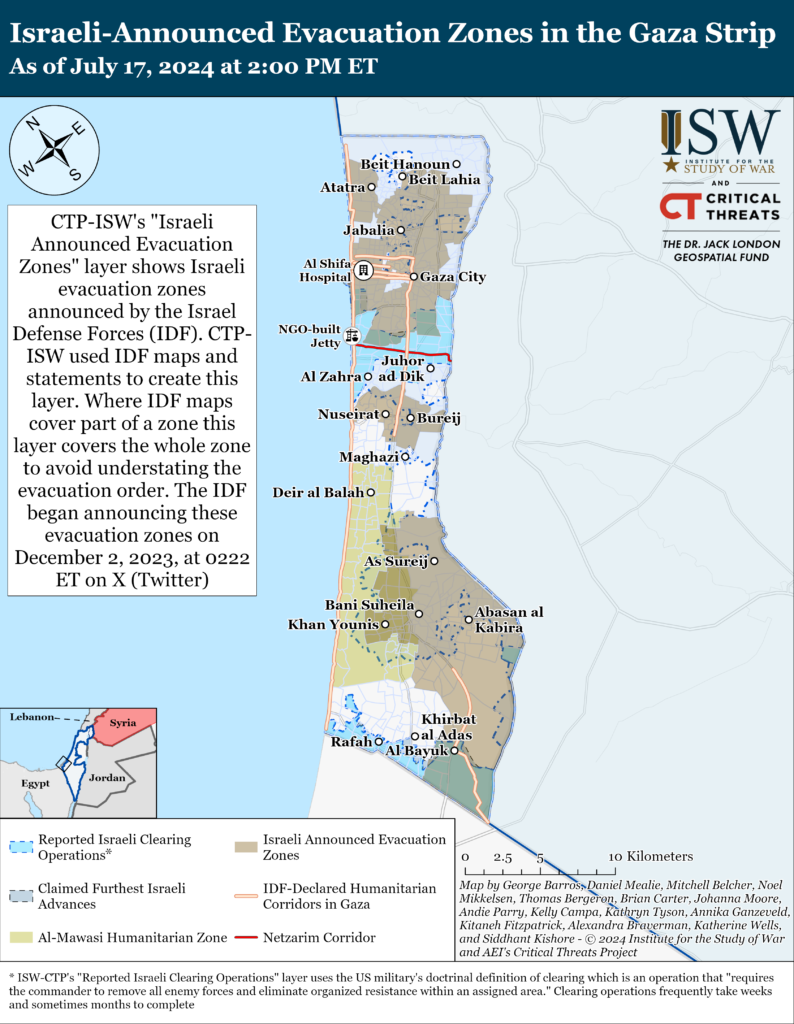
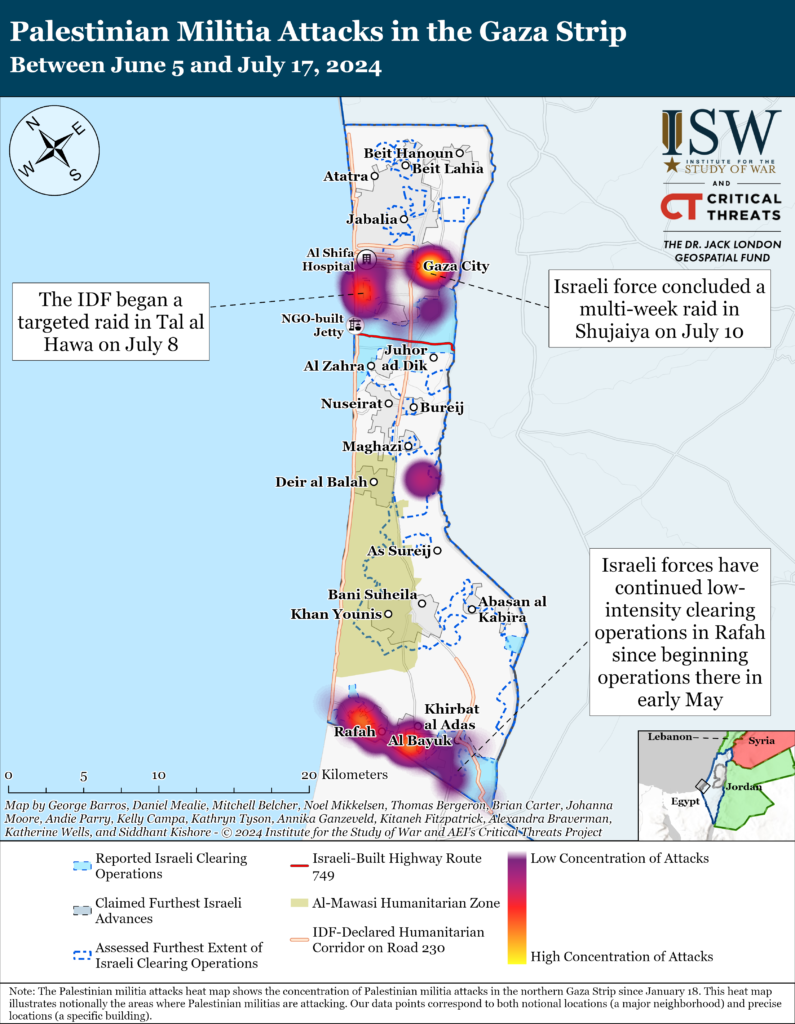
Senior US military officials engaged with their Israeli counterparts over the past week. US Central Command Commander Gen. Michael Kurilla met with IDF Chief of Staff Herzi Halevi in Israel.[xxxviii] US Secretary of Defense Lloyd Austin and Israeli Defense Minister Yoav Gallant separately spoke on the phone about the IDF’s ongoing operations in Gaza Strip, a possible ceasefire deal, and the specifics of the July 13 strike targeting Hamas’ top military commander, Mohammad Deif.[xxxix]
Palestinian militias conducted at least two rocket attacks from the Gaza Strip into southern Israel on July 17. The Palestinian Mujahideen Movement fired rockets at an IDF headquarters and an Israeli town.[xl]
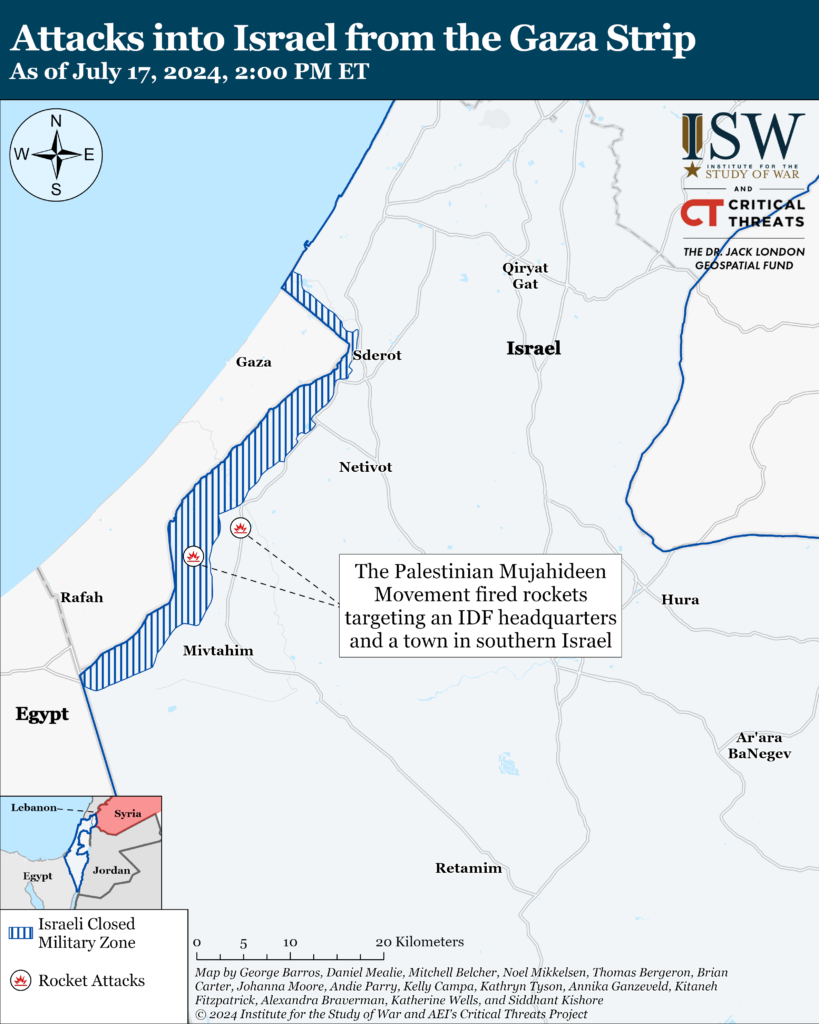
Recorded reports of attacks; CTP-ISW cannot independently verify impact.
West Bank
Axis of Resistance objectives:
Establish the West Bank as a viable front against Israel
Israeli forces have engaged Palestinian fighters in seven locations in the West Bank since CTP-ISW’s last data cut off on July 16.[xli] The al Aqsa Martyrs’ Brigades, Hamas, and Palestinian Islamic Jihad fired small arms and detonated improvised explosive devices (IED) targeting Israeli forces in Jenin.[xlii]
Hamas said on July 17 that it conducted a small arms attack that wounded three Israeli civilians in Ramin, east of Tulkarm, on July 16.[xliii] Hamas said that the attack was in response to Israeli action in the Gaza Strip and West Bank and it threatened to conduct further attacks in the West Bank.[xliv]
The US State Department imposed visa restrictions on a former IDF sergeant on July 17 for violating human rights in the West Bank.[xlv] The State Department designated Elor Azaria for his involvement in an extrajudicial killing in Hebron in 2016.[xlvi] Azaria was in the IDF at the time of the incident. The State Department also said that it was taking steps to impose visa restrictions on an additional group of individuals for ”having been involved in or meaningfully contributed to undermining the peace, security, or stability in the West Bank.”[xlvii]
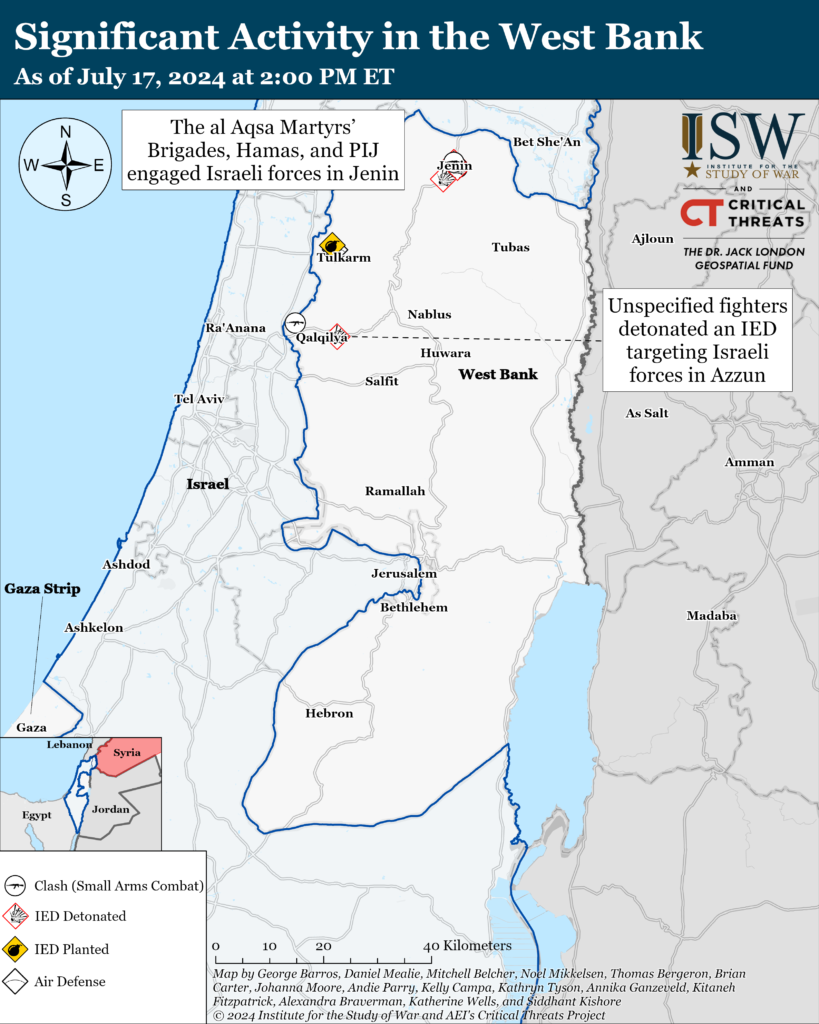
This map is not an exhaustive depiction of clashes and demonstrations in the West Bank.
Southern Lebanon and Golan Heights
Axis of Resistance objectives:
Deter Israel from conducting a ground operation into Lebanon
Prepare for an expanded and protracted conflict with Israel in the near term
Expel the United States from Syria
Lebanese Hezbollah conducted at least eight attacks from southern Lebanon into northern Israel since CTP-ISW’s last data cut-off on July 16.[xlviii] Hezbollah targeted seven civilian towns and one IDF barracks. The IDF detected approximately 25 rocket launches from Lebanese territory on July 16 and intercepted ”some” of them.[xlix] The IDF sometimes elects not to shoot down rockets if the rockets are on a trajectory that will hit a field or other uninhabited areas. The IDF reported that neither attack resulted in casualties.[l] Hezbollah claimed that the strikes were in retaliation for Israeli strikes targeting Hezbollah fighters and infrastructure across southern Lebanon on July 15 and 16.[li]
Hezbollah Secretary General Hassan Nasrallah threatened to strike new locations inside Israel on July 17.[lii] Nasrallah gave a televised speech on July 17 commemorating the Shia holy Day of Ashura and stated that Hezbollah would hit new Israeli targets if Israel “continues to target civilians” in Lebanon.[liii] CTP-ISW has observed that Hezbollah has attacked areas further south in Israel in retaliation for recent Israeli strikes targeting Hezbollah leaders. Nasrallah dismissed the idea that conflict between Israel and Hezbollah would be resolved through diplomacy, instead stating that the future of southern Lebanon will be decided by the “results of this battle.” Nasrallah is presumably referring to Israel-Hezbollah fighting along the northern border and a future Israeli military offensive into Lebanon.[liv] The United States and other international partners have attempted since fall 2023 to engage Lebanon, Hezbollah, and Israel to resolve the ongoing escalation diplomatically.[lv] Israeli officials have said repeatedly that they are attempting to reach a diplomatic agreement wherein Hezbollah will withdraw north of the Litani River in Lebanon, but that Israel may need to resort to military action against Hezbollah in the absence of a diplomatic solution.[lvi] UNSC Resolution 1701, which ended the 2006 Lebanon War, stipulates that Hezbollah cannot maintain military positions south of the Litani. [lvii]
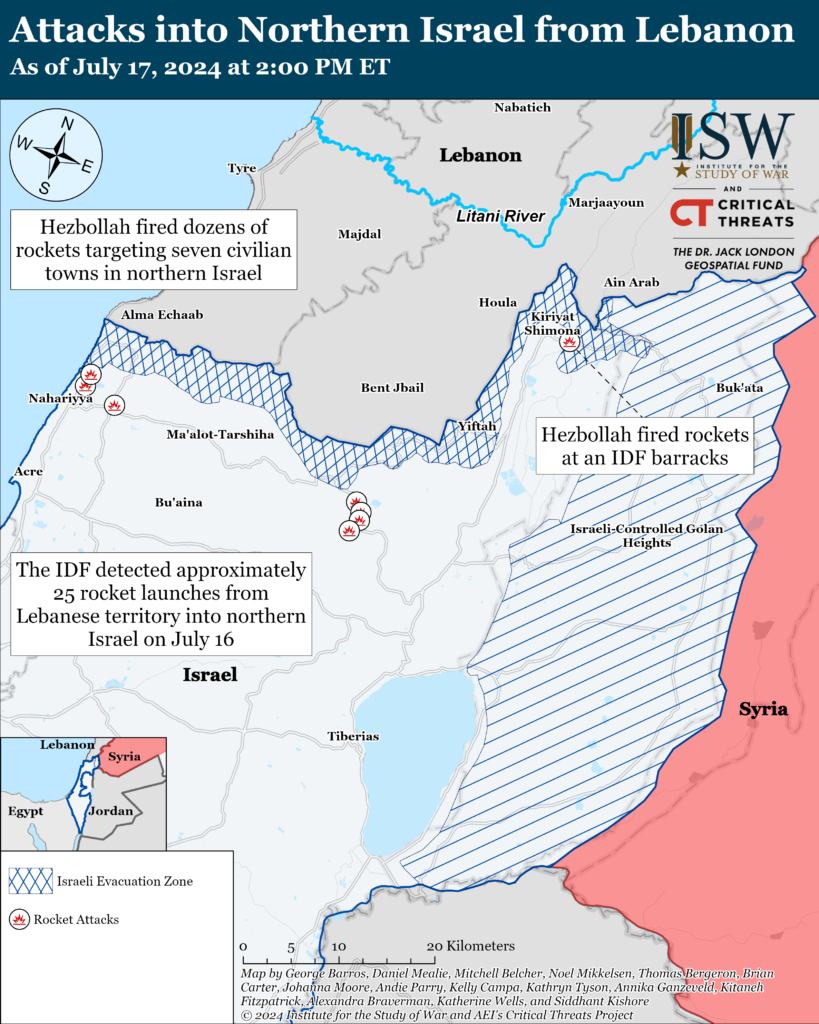
Recorded reports of attacks; CTP-ISW cannot independently verify impact.
Iran and Axis of Resistance
The Islamic Resistance in Iraq—a coalition of Iranian-backed Iraqi militias—claimed a drone attack targeting Ma’agalim base in Israel on June 16.[lviii] The Islamic Resistance in Iraq also claimed a drone attack targeting “a vital target” in Eilat on June 17.[lix] The IDF has not confirmed the attacks as of this writing.
Iranian President-elect Masoud Pezeshkian conducted separate phone calls with several global leaders, including the leaders of Saudi Arabia and Qatar, on July 17.[lx] Pezeshkian also spoke with the president of Uzbekistan, the vice president of Brazil, and the prime minister of Malaysia. The various officials congratulated Pezeshkian on his election and reaffirmed their intentions to deepen ties with Iran. Saudi Crown Prince and Prime Minister Mohammad bin Salman said he hoped to continue cooperation between Iran and Saudi Arabia across ”various fields.”[lxi] Pezeshkian thanked Qatar for its help opposing Israeli military operations in the Gaza Strip in his call with Qatari Emir Sheikh Tamim bin Hamad al Thani.[lxii] Brazilian Vice President Geraldo Alckmin and Uzbek President Shaukat Mirziyoyev both separately proposed joint economic commissions with Iran to increase bilateral trade.[lxiii] Malaysian Prime Minister Datuk Seri Anwar Ibrahim expressed support for the continuation of bilateral relations free from foreign interference and commended Iran for its ”unwavering support for justice for the Palestinian people.”[lxiv]
Acting Iranian Foreign Affairs Minister Ali Bagheri Kani discussed Iran’s support for the Axis of Resistance during a speech at the United Nations Security Council (UNSC) meeting on July 16.[lxv] Bagheri Kani called Iran’s support for the Axis of Resistance a ”legitimate action” in the framework of international law. Bagheri Kani separately met with his Russian, Kuwaiti, and Hungarian counterparts on the sidelines of the UNSC on July 17.[lxvi] Bagheri Kani reiterated warnings against a potential Israeli offensive operation against Lebanese Hezbollah in the meetings with his Russian and Hungarian counterparts and in a separate July 17 speech about Palestine.[lxvii] Bagheri Kani separately gave interviews with Russian and American news outlets on the sidelines of the UN.[lxviii]
 Eurasia Press & News
Eurasia Press & News
